About FODM
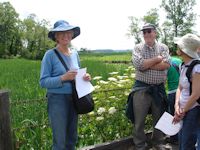 Dr. Elizabeth Wells leads plant walks in Dyke Marsh. Photo by Glenda Booth.The Friends of Dyke Marsh (FODM) was formed in 1976 by a group of local people who, initially, wanted to stop plans to use the marsh as a dumping ground for dredged river spoil. This was yet another insult to the wetland; in the 1930s, construction debris had been heaped into the marsh and some of it is still visible today. The group formally organized as a non-profit organization for the purpose of cooperating with the U.S. National Park Service (NPS) in promoting the well-being of the marsh and preserving and restoring it. FODM was incorporated in 1976.
Dr. Elizabeth Wells leads plant walks in Dyke Marsh. Photo by Glenda Booth.The Friends of Dyke Marsh (FODM) was formed in 1976 by a group of local people who, initially, wanted to stop plans to use the marsh as a dumping ground for dredged river spoil. This was yet another insult to the wetland; in the 1930s, construction debris had been heaped into the marsh and some of it is still visible today. The group formally organized as a non-profit organization for the purpose of cooperating with the U.S. National Park Service (NPS) in promoting the well-being of the marsh and preserving and restoring it. FODM was incorporated in 1976.
Since 1975, the Friends have continued and expanded their volunteer work. Our efforts include holding quarterly meetings and other programs open to the public; publishing a newsletter titled The Marsh Wren; raising money to sponsor scientific studies of the marsh; conducting nature walks; conducting surveys, including the annual breeding bird survey; hosting trash cleanups; preparing informational materials; encouraging public stewardship; maintaining this website and a Facebook page; and helping NPS control invasive 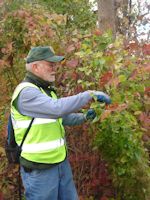 Lew Cabe is a member of the FODM team that works to control non-native, invasive plants. Photo by Glenda Booth.plants.
Lew Cabe is a member of the FODM team that works to control non-native, invasive plants. Photo by Glenda Booth.plants.
The Friends also advocate for conservation and restoration and oppose inappropriate activities that degrade the health of the marsh as a wildlife habitat. For a more complete history of the park and the Friends of Dyke Marsh, see Dyke Marsh Wildlife Preserve, A Chronology.
Our Mission
The Friends of Dyke Marsh are dedicated to preserving, protecting and restoring the Dyke Marsh Wildlife Preserve, in partnership with the National Park Service, as a vital wildlife habitat, through education, science, advocacy and stewardship. Our vision is that Dyke Marsh will someday be a healthy, vital, self-sustaining, biodiverse ecosystem.
Thanks go to our many supporters, including many public officials.
FODMers Work to Protect and Restore Dyke Marsh
Some Examples of What We Do
Sponsor programs
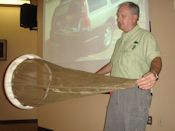
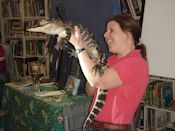 Monarch butterfly expert Larry Brindza gave a presentation to FODMers describing how he catches and tags monarch butterflies.
Monarch butterfly expert Larry Brindza gave a presentation to FODMers describing how he catches and tags monarch butterflies.
Caroline Seitz of Reptiles Alive used live reptiles in her presentation to FODMers. This alligator is not found in Dyke Marsh.
Support Science
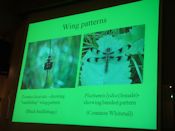
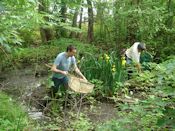 FODM supported a dragonfly and damselfly survey in the preserve, conducted by Chris Hobson of the Virginia Natural Heritage Program, which he presented at a FODM meeting in 2012.
FODM supported a dragonfly and damselfly survey in the preserve, conducted by Chris Hobson of the Virginia Natural Heritage Program, which he presented at a FODM meeting in 2012.
FODMers conduct surveys, for example, of reptiles and amphibians.
Lead nature walks
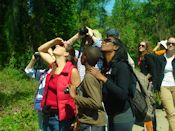
 FODMers lead bird walks every Sunday morning at 8 a.m.
FODMers lead bird walks every Sunday morning at 8 a.m.
FODM volunteers co-lead a plant walk every fall.
Conduct surveys

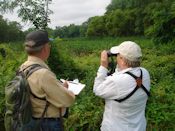 For over 20 years, FODMers have conducted a breeding bird survey. Larry Cartwright organizes it, compiles records of breeding birds and submits data to the National Park Service.
For over 20 years, FODMers have conducted a breeding bird survey. Larry Cartwright organizes it, compiles records of breeding birds and submits data to the National Park Service.
Larry Cartwright, leader of the annual breeding bird survey, and Laura Sebastianelli surveyed birds in the western part of Dyke Marsh for the first time in July 2015.
Introduce decision-makers to Dyke Marsh
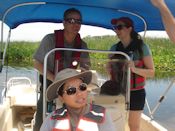
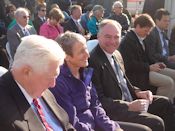 In July 2015, with the assistance of NPS biologists Erik Oberg (steering the boat) and Brent Steury, FODM introduced two of Congressman Beyer's staff to the Dyke Marsh Wildlife Preserve. Standing: Kate Schisler. Seated: ChoYi Kwan.
In July 2015, with the assistance of NPS biologists Erik Oberg (steering the boat) and Brent Steury, FODM introduced two of Congressman Beyer's staff to the Dyke Marsh Wildlife Preserve. Standing: Kate Schisler. Seated: ChoYi Kwan.
On October 24, 2013, Department of Interior Secretary Sally Jewell came to Dyke Marsh to announce the award of a $25 million grant to restore Dyke Marsh. Seated: Congressman Jim Moran; Secretary Jewell; Virginia Senator Tim Kaine; Virginia Delegates Rob Krupicka and Scott Surovell.
Host school and other groups
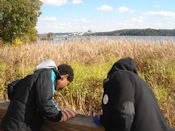
 Since 2012, students from the T.C. Williams High School International Academy have visited Dyke Marsh in the spring to learn and help control invasive plants.
Since 2012, students from the T.C. Williams High School International Academy have visited Dyke Marsh in the spring to learn and help control invasive plants.
Students from nearby Belle View Elementary School visit Dyke Marsh. NPS Ranger Emily Zivot helped us describe the spatterdock to them.
Encourage public stewardship

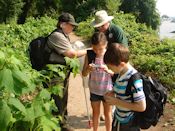 FODM participates in the Gum Springs Community Day. Here Ned Stone helps a young visitor make a paper bird.
FODM participates in the Gum Springs Community Day. Here Ned Stone helps a young visitor make a paper bird.
FODM and National Park Service staff introduce the next generation to environmental stewardship. Here Laura Sebastianelli, in NPS uniform, and Greg Crider, FODMer, discuss insects with Mara and Colin Surovell.
Educate the public

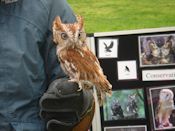 Every year, FODM and the National Park Service sponsor Raptor Rapture to introduce the public to these amazing birds and their needs.
Every year, FODM and the National Park Service sponsor Raptor Rapture to introduce the public to these amazing birds and their needs.
Organize trash cleanups

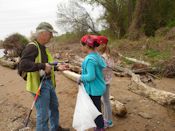 FODMers participate in the annual Alice B. Ferguson Potomac River Trash Cleanup every spring and conduct other cleanups throughout the year.
FODMers participate in the annual Alice B. Ferguson Potomac River Trash Cleanup every spring and conduct other cleanups throughout the year.
Community groups like the Girl Scouts help us clean up trash.
Attack invasive plants

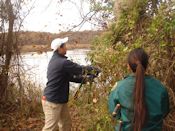 NPS staffer Kenneth Adams helps train volunteers. Here he tackles the very invasive porcelainberry.
NPS staffer Kenneth Adams helps train volunteers. Here he tackles the very invasive porcelainberry.
Members of the Student Conservation Corps help FODMers try to control invasive plants.
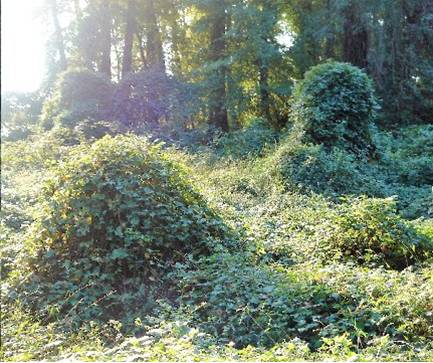 |
|
The Dyke Marsh Wildlife Preserve, like many Northern Virginia properties, is unfortunately riddled with non-native plants. Areas on both sides of the Dyke Marsh Haul Road, the walking trail, are particularly overwhelmed with invasives, like many areas in northern Virginia. Invasive plants are often found in disturbed areas. The Haul Road, as fill, is a classic example. It was built as a service road by the people who dredged and hauled away half of Dyke Marsh between 1940 and 1973. Fortunately, the National Park Service (NPS) is trying to better control these plants, but it is truly an uphill battle. Non-natives do not co-evolve with native insects and other animals and usually provide little food value to wildlife. NPS biologist Erik Oberg calls invasive plants like bush honeysuckle “junk food” for birds. Plants like orcelainberry and English ivy can outcompete, destroy and smother native, understory plants. Porcelainberry vines smother trees, shrubs and plants in summer and fall (see photo, right by G. Booth). FODM volunteers work to control invasive plants. To volunteer, visit our Volunteer / Help page.

 Friends of Dyke Marsh, Inc. is a non-profit 501(c)(3) organization.
Friends of Dyke Marsh, Inc. is a non-profit 501(c)(3) organization.